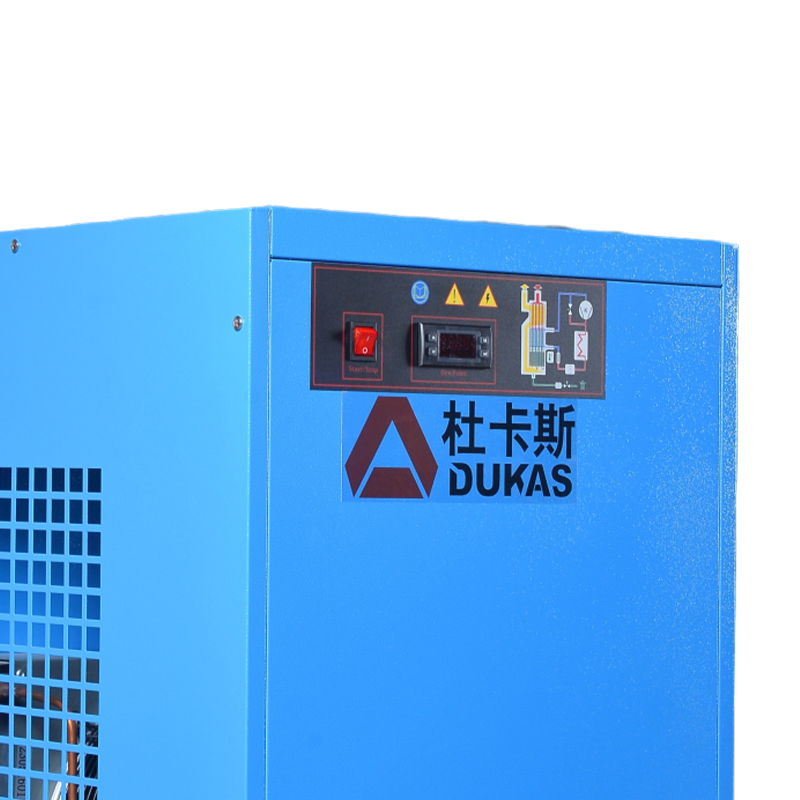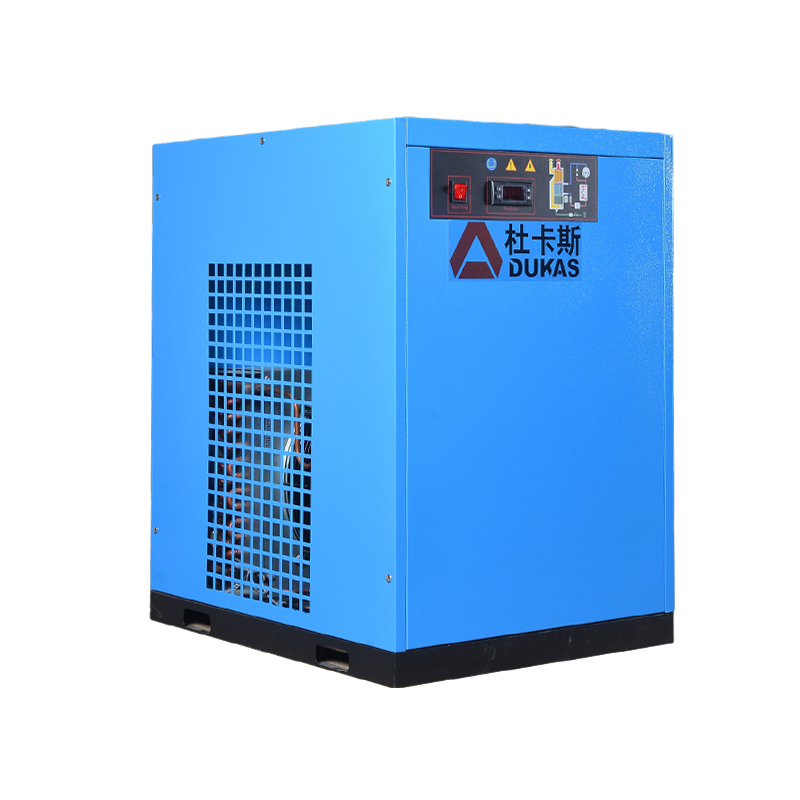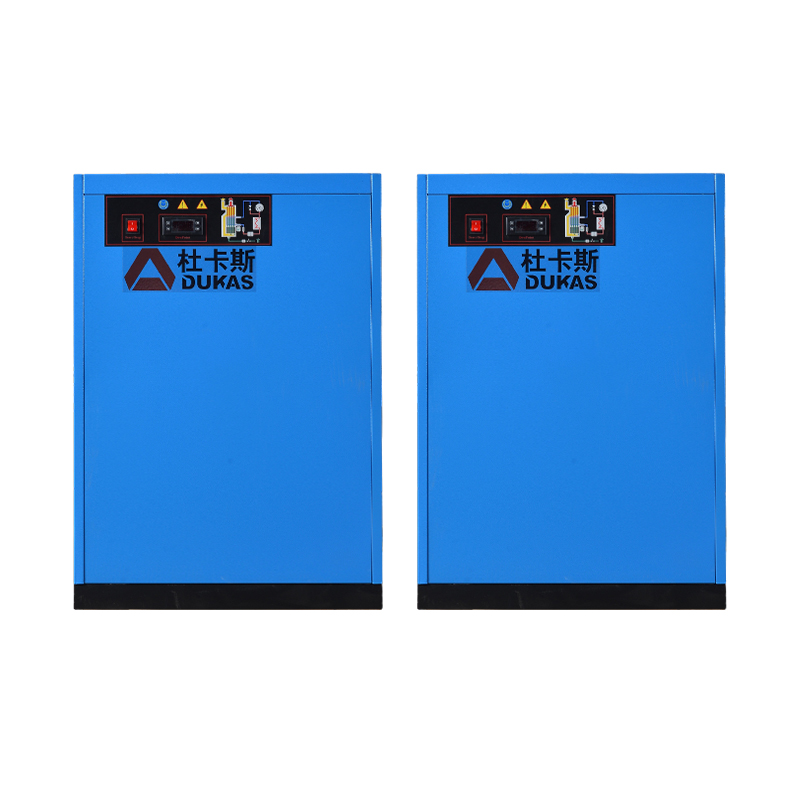Qalajiyaha qaboojiyaha waa aalad u adeegsada tikniyoolajiyadda qaboojiyaha si loo qalajiyo hawo isku buuqsan. Mabda 'shaqadeeda shaqadu waa in la adeegsadaa saameynta qaboojiyaha qaboojiyaha si uu u dul maro qoyaanka hawada isku buuqsan, ka dibna ka saar qoyaanka aaladda filterka si loo helo hawo qalalan. Hawshani waxay badanaa ku lug leedahay qaybaha aasaasiga ah sida stempess, oo la adeegsanayo, uumi baxayaasha iyo ubus-ka-ka-goosadaha biyaha.
Qiyaasta qabow ee ugu badan ee suuqa waxaa loo qaddarin karaa inay yeeshaan dhibic sawadeed oo ah 2-10 ° C, tusaale ahaan, heerkulka dhibcaha sayaxu waa 10 ° C oo ah cadaadiskii 0.7MPA; Marka cadaadiska uu ku dhaco cadaadiska jawiga, heerkulka u dhigma dhibicda dhibcaha ayaa ah -16 ° C. Sidaa darteed, wax dhib ah malahan isticmaalka qalajiyaha qabow xilliga qaboobaha. Si kastaba ha noqotee, wali waa lagama maarmaan in fiiro gaar ah la siiyo xaaladdeeda shaqaalaynta iyo hufnaanta isticmaalka iyo maareynta si looga hortago fashilka sababi kara carqalado gaar ah iyo xiritaanka qalabka.
1. Taxaddarrada isticmaalka xilliga qaboobaha
Ka hortag qaboojinta
Ilaalinta tuubooyinka biyaha, tuubbooyinka iyo isku-darka: Marka heerkulku hooseeyo xilliga qaboobaha, qoyaanka qalabka ayaa fududahay in la qaboojiyo tuubooyinka biyaha, tuunbooyinka biyaha iyo waxyaabaha ku jira. Sidaa darteed, qalabku wuxuu u baahan yahay in lagu sifeeyo ka hor inta aan la isticmaalin si loo hubiyo in heerkulka hawlgalka uusan ka hooseyn 0 ° C. Intaas waxaa sii dheer, qaybahaas waa in si joogto ah loogu hubiyaa si joogto ah u sameynta barafka waana in si dhakhso leh loola macaamilaa haddii la helo.
Heerkulka Heerkulka Gudaha: Markaad isticmaaleyso qalajiyaha qaboojiyaha xilliga qaboobaha, heerkulka gudaha ah waa in si macquul ah loo xakameeyaa si looga fogaado waxyeelada xun ee ku saabsan qalabka si heerkulka ugu hooseeya.
Xulashada qaboojiyaha
Waxqabadka waxaa saameeya heerkulka: waxqabadka qaboojiyaha ayaa isbedelaya isbeddelada heerkulka. Xilliga jiilaalka, heerkulka hoose awgeed, saameynta qaboojiyaha ee qaboojiyaha ayaa yaraanaya, sidaasna saameyn ku leh saameynta qalajinta qalabka. Sidaa darteed, waxaa lagama maarmaan ah in si macquul ah loo xusho qaboojiyaha iyadoo la raacayo heerkulka deegaanka, huurka iyo xaaladaha kale si loo hubiyo hawlgalka caadiga ah ee qalabka.
Hawlgal diiran
Baahiyaha Kare ayaa sidoo kale wareegi kara qaboojiyaha si buuxda oo si buuxda u hagaajinaya hufnaanta qalajinta.
Qaabka Howlgalka: Inta aadan isticmaalin, waxaad bilaabi kartaa aaladda ka dhibka leh ama ha ku shubi kartaa qalabka muddo ah waqti aad ku dhisanto. Waqtiga ka-hortagga ah wuxuu kuxiran yahay nooca qalabka iyo heerkulka banaanka. Waxaa guud ahaan lagula talinayaa in lagu horjoogsado 30 daqiiqo ka hor intaadan bilaabin qalabka.
Kormeerka joogtada ah iyo dayactirka
Waxyaabaha kormeerka ah: Xaaladda tuubooyinka biyaha, tuubooyinka biyaha, waxyaabaha ku jira iyo qaboojiyaha qalabka waa in si joogto ah loo hubiyaa inay hubiyaan inay ku jiraan xaalad shaqo oo wanaagsan. Intaa waxaa sii dheer, hubi qulqulka soodhada iyo ka-dhiska biyaha si loo hubiyo in dheecaanku uu yahay mid siman oo aan la xakamayn karin.
Habka dayactirka: wixii dhibaatooyin ah ama waxyaabo aan caadi ahayn oo la helo waa in wax laga qabtaa loona ilaaliyaa hab ku habboon. Tusaale ahaan, haddii biibiilaha biyuhu la helo in la qaboojiyo, waa in si dhakhso ah loo joojiyaa si loo burburiyo; Haddii qaboojiyaha la helo inuusan ku filnayn ama waxqabadka uu liito, qaboojiyaha waa in dib loo buuxiyaa ama lagu beddelaa waqtiga.
2. Faa'iidooyinka iyo caqabadaha isticmaalka xilliga qaboobaha
Faa'iidooyinka
Kartida qaboojinta sare: Xilliga jiilaalka, heerkulka ugu hooseeya awgeed, hufnaanta qaboojinta ee qalajiyaha qaboojiyaha ayaa badanaa ka badan. Tani waxay gacan ka geysaneysaa gaarista heerkulka dhibic hoosaadka sayaxa hoose, taas oo markaa hagaajiso natiijooyinka qalajinta. Isticmaalka tamarta oo yaraatay Sababtoo ah qalabku uma baahna inuu isticmaalo tamar aad u badan si loola dagaallamo saameynta heerkulka sare iyo huurka sare ee saamaynta qalajinta.
3. Khatarta kordhay ee qaboojinta Waxqabadka Qaboojiyaha Hoos u dhaca: In kasta oo hufnaanta qaboojinta ay aad u sarreyso xilliga qaboobaha, waxqabadka qaboojiyaha sidoo kale waxaa saameyn ku yeelan kara heerkulka hoose oo hoos u dhaca. Tani waxay u baahan tahay taxaddar weyn xagga xulashada iyo adeegsiga qaboojiyaha.
4. Istaraatiijiyadaha kobcinta iyo talooyinka
Xoojinta tillaabooyinka dahaarka
Tuubbada tuubbooyinka Qolka qolka kumbuyuutarka: Haddii qalabka lagu rakibay qolka kumbuyuutarka, qolka kumbuyuutarka ayaa lagu qasbi karaa inuu hagaajiyo xasilloonida qolka kumbuyuutarka ee qolka kumbuyuutarka.
Adeegso daawada xinjirowga
Ku darista xaddiga saxda ah ee dawooyinka dawooyinka lidka ku ah gudaha qalabka ayaa yareyn kara hoostiisa biyaha, taas oo lagu yareyn karo halista qaboojinta. Si kastaba ha noqotee, waa in la ogaadaa in isticmaalka dawooyinka xinjirowga xinjirowga lidka ku ah ay tahay inay u hoggaansamaan shuruudaha qalabka iyo heerarka ku habboon.
Hagaaji xuduudaha hawlgalka
Ku hagaaji cabbirrada hawlgalka ee qalabka, sida qulqulka qaboojiyaha, xawaaraha compressor, iwm.
Xoojinta kormeerka iyo digniinta ugu horeysa
La soco heerka hawlgalka iyo isbeddelada xudunta ee qalabka waqtiga dhabta ah, oo wax ka qabtaan wixii aan caadi ahayn oo aan caadi ahayn haddii aan waxeeyo aan caadi ahayn la helo. Isla mar ahaantaana, habaynta digniinta ugu horayso ayaa loo aasaasay si loo ogaado dhibaatooyinka ka hormarinaya horay loo qaado oo ay qaadaan tallaabooyin u dhigma si looga hortago.
Tababar iyo hagitaan
Bixi tababar xirfadeed iyo hagitaan howl wadeenada si loo wanaajiyo xirfadahooda howsha iyo wacyigelinta amniga. Tani waxay gacan ka geysaneysaa yareynta qalabka fashilka iyo shilalka badbaadada ee ay sababaan hawlgal aan habooneyn.
Isku soo wada duuboo, qalajiyaha qaboojiyaha ayaa loo isticmaali karaa xilliga qaboobaha, laakiin daryeelka ayaa loo baahan yahay in loo qaado si looga hortago tuubooyinka biyaha, tuunbooyinka iyo waxyaabaha ka shaqeeya qaboojinta. Iyada oo loo marayo xulashada macquul ah ee qaboojiyaha, xoojinta talaabooyinka daweynta, adoo isticmaalaya qiyaasta dawooyinka lidka ku ah, iyo xoojinta kormeerka iyo digniinta hore ee qalabka iyo nolosha adeegga la dheereeyey waa la hubin karaa. Isla mar ahaantaana, tababar xirfadeed iyo hagitaan loogu talagalay hawlwadeenka sidoo kale waa hab muhiim ah oo lagu wanaajiyo qalabka wax ka qabashada hufnaanta iyo amniga.

Waqtiga Post: Oktoobar-21-2024



